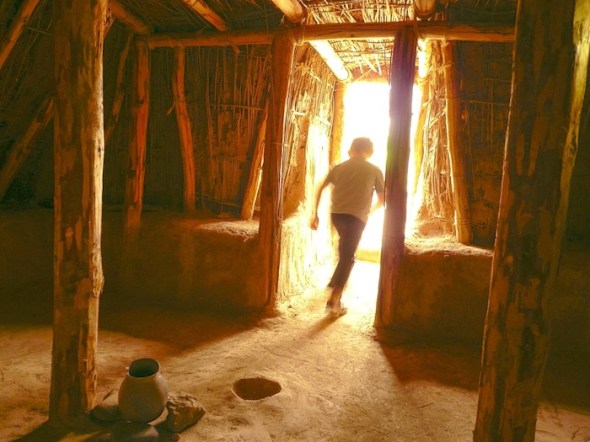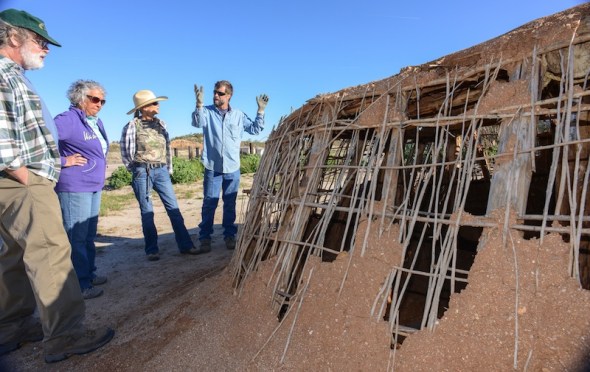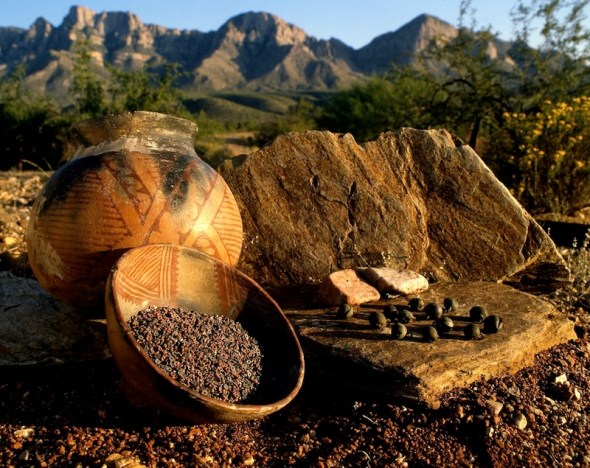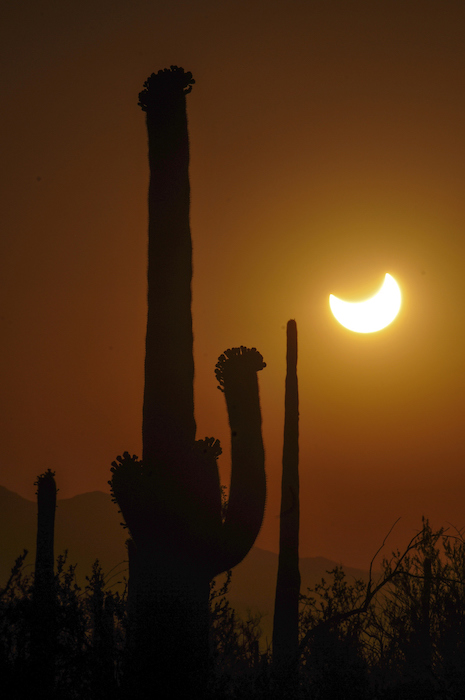HONEY BEE PIT HOUSE CONSTRUCTION MAPS OUT THE HOHOKAM’S LIFE WAYS AT STEAM PUMP RANCH IN ORO VALLEY EXPANDING THE PREHISTORIC RECORD !

Allen Denoyers is building a Hohokam village on Tucson’s northwest side. Visitors to Oro Valley’s historic
Steam Pump Ranch can crawl between two wood uprights and find themselves transported back to 900 AD.  The southwest archaeologist has propelled his career by taking prehistoric technology into his hands and by learning from the past and teaching his students what life was like a thousand years ago. Denoyers passion for the past has taken many different forms, since junior high school, the self-taught flintknapper has created knifes, axes, spears, atlatls and now prehistoric pit houses. Archaeology Southwest, a local archaeology research firm, where Denoyer works, has long been responsible for expanding the prehistoric record by their survey of endangered sites and filling in the holes of existing knowledge about the folks who once lived here in the Sonoran Desert. So when Denoyer built his first pilot pit house, he was working from the knowledge gained from the past century of southwest archaeology and in partnership with the Town of Oro Valley and the Oro Valley Historical Society. In truth, most of what is known about the Hohokam pit house are the holes in the ground left behind by the wood uprights stuck in the ground centuries ago. The roofing, side and interior of these homes today are modeled on historic homes of the Hohokam descendents that today, are known as the Tohono O’odham and Pima people, of Southern Arizona.
The southwest archaeologist has propelled his career by taking prehistoric technology into his hands and by learning from the past and teaching his students what life was like a thousand years ago. Denoyers passion for the past has taken many different forms, since junior high school, the self-taught flintknapper has created knifes, axes, spears, atlatls and now prehistoric pit houses. Archaeology Southwest, a local archaeology research firm, where Denoyer works, has long been responsible for expanding the prehistoric record by their survey of endangered sites and filling in the holes of existing knowledge about the folks who once lived here in the Sonoran Desert. So when Denoyer built his first pilot pit house, he was working from the knowledge gained from the past century of southwest archaeology and in partnership with the Town of Oro Valley and the Oro Valley Historical Society. In truth, most of what is known about the Hohokam pit house are the holes in the ground left behind by the wood uprights stuck in the ground centuries ago. The roofing, side and interior of these homes today are modeled on historic homes of the Hohokam descendents that today, are known as the Tohono O’odham and Pima people, of Southern Arizona.
When Hurricane Norbert dropped four inches of rain on Oro Valley last September, swelling washes to ten feet deep in places and requiring local fire and police to rescue motorists from swollen washes and flooded roadways. Loads of mud sloughed off Denoyers pit house completely filling it with water. That’s when the learning began for Archaeology Southwest who figured 40-50 percent of the mud was lost. Mud from the upper portions of the walls washed away or slumped in. The roof actually stayed relatively intact, with losses mostly confined to the edges. “But we don’t see this as a tragedy—in fact, we’re
roadways. Loads of mud sloughed off Denoyers pit house completely filling it with water. That’s when the learning began for Archaeology Southwest who figured 40-50 percent of the mud was lost. Mud from the upper portions of the walls washed away or slumped in. The roof actually stayed relatively intact, with losses mostly confined to the edges. “But we don’t see this as a tragedy—in fact, we’re
 re-mudding they laid thatch mats over the new openings allowing air to circulate. Perhaps we need more thatching or interior support and possibly a different mixture of water and mud, to better combat the elements. Getting the moisture content of the earth just right is a real art, “I love the sound of the mud”, says Denoyer as he applies a rock to the wet surface smoothing it and creating a slick surface. “Floating the mud gives it a sheen and when the rain hits-it just rolls off.” “It really doesn’t take all that much work”, he says of pit house construction, “five or six people working together could finish in a couple of days”. “I love digging, screening earth, being out here all day. I’m so lucky so many people hate their work. At the end of the day, you can step back and appreciate what you accomplished.”
re-mudding they laid thatch mats over the new openings allowing air to circulate. Perhaps we need more thatching or interior support and possibly a different mixture of water and mud, to better combat the elements. Getting the moisture content of the earth just right is a real art, “I love the sound of the mud”, says Denoyer as he applies a rock to the wet surface smoothing it and creating a slick surface. “Floating the mud gives it a sheen and when the rain hits-it just rolls off.” “It really doesn’t take all that much work”, he says of pit house construction, “five or six people working together could finish in a couple of days”. “I love digging, screening earth, being out here all day. I’m so lucky so many people hate their work. At the end of the day, you can step back and appreciate what you accomplished.”
Archaeology Southwest has taken the next step to learn from the past, under the tutelage of Denoyer, the
research firm is offering several ongoing workshops, where participants will learn the basics of pit house  construction as archaeologists have learned from excavations. Denoyer will lead participants through the construction process, from excavation of the house pit to creating the superstructure, putting each student hands-on with traditional tools and materials. Through this work, Archaeology Southwest hopes to add detail to archaeological knowledge of how these structures were made by ancient people. Workshop sessions take place at Steam Pump Ranch in Oro Valley. Each session will last for three hours. Initial sessions will be dedicated to repairing rain-damages
construction as archaeologists have learned from excavations. Denoyer will lead participants through the construction process, from excavation of the house pit to creating the superstructure, putting each student hands-on with traditional tools and materials. Through this work, Archaeology Southwest hopes to add detail to archaeological knowledge of how these structures were made by ancient people. Workshop sessions take place at Steam Pump Ranch in Oro Valley. Each session will last for three hours. Initial sessions will be dedicated to repairing rain-damages  to the 2014 pit house. After that pit house is restored, participants will create small test pit houses that will enable us to compare how slightly different methods and materials respond to time and weather. Class Dates: Friday 3/6/15 from 9:00am-12:00pm – $40.00, Friday 3/13/15 from 9:00am-12:00pm, Friday 4/10/15 from 9:00am-12:00pm, Thursday 4/16/15 from 9:00am-12:00pm, Friday 4/24/15 from 9:00am-12:00pm -classes are for participants 18 years and older, there is a $40.00 charge.
to the 2014 pit house. After that pit house is restored, participants will create small test pit houses that will enable us to compare how slightly different methods and materials respond to time and weather. Class Dates: Friday 3/6/15 from 9:00am-12:00pm – $40.00, Friday 3/13/15 from 9:00am-12:00pm, Friday 4/10/15 from 9:00am-12:00pm, Thursday 4/16/15 from 9:00am-12:00pm, Friday 4/24/15 from 9:00am-12:00pm -classes are for participants 18 years and older, there is a $40.00 charge.
ONE STUDENTS IMPRESSIONS ON THE HANDS-ON PIT HOUSE CLASS

Allen Denoyer explains the class to Terri and Dave Wallace while Joyce Holloway listens to the plan.
Denoyer has based the pit houses his classes are building on homes found in Honey Bee Village, an Oro Valley
Hohokam site, the 32 acres excavated by Henry Wallace, in 1986, his study turned up more than 2000 features, including 100’s of pit houses, a large plaza and a small ball court which established Honeybee as the economic center of several villages situated along the Canada del Oro River. The ball court Wallace believes was based on the Mesoamerican ball game, played with a rubber ball batted around with paddles perhaps resembling those used today in ping pong. The ball game, Wallace believes, was an “integrative tool” to bring folks together and exchange goods creating a “large trade fair”, around 800 AD, in the village’s center plaza. The larger excavation of the Tortolita foothills was undertaken by Desert Archaeology because of the advancing bulldozers for the development of the 5000 acre Rancho Vistoso housing project that today has covered over or bull-dozed many other sites right off the face of the earth. Honeybee’s sister site the larger “Sleeping Snake”, where “not much is left” says Wallace of the site now covered by a golf course. So when Wallace got to Honey Bee, the archaeologist trenched the village core and conducted a systemic shed collection, learning a lot about the residents of the 100’s
archaeologist trenched the village core and conducted a systemic shed collection, learning a lot about the residents of the 100’s of homes characterized by large oblong holes in the ground encircled by holes left by the pole uprights supporting the pit house village. Wallace believes the life of a pit house was 15-20 years and believed Honey Bee which was a “great place of ak-chin farming” said Wallace of the wide flood plain along Big Wash.
of homes characterized by large oblong holes in the ground encircled by holes left by the pole uprights supporting the pit house village. Wallace believes the life of a pit house was 15-20 years and believed Honey Bee which was a “great place of ak-chin farming” said Wallace of the wide flood plain along Big Wash. It never supported more than a 100 people at any given time, saying the village’s population was “between 40-90 people at any given time” and that Honey Bee” was not alone but part of something larger”. Denoyer points out supplies were limited and not everyone could build a pit house whenever they wanted. “They wouldn’t pull out the plants”. which grew along side of the Canada del Oro River which provided weep willows, for the necessary wall and roof support, for the Hohokam pit house, instead “they would cut the plant and it would grow back the next year” and more homes could then be built. Carbon 14 dating has placed some of the wood found around 1050 AD, and Wallace feels the wood was carried a great distance, climbing into the Catalina Mountains and carrying it many miles home. There was a lot of competition for building supplies, Honey Bee was far from alone along the CDO, notably the Romero Ruin now protected in Catalina State Park and Rooney Ranch site was bulldozed, and now is named after a shopping center. There were fifty pit houses and the bulldozers had entire pots rolling down the hillside, along with burials from between 700AD to 1380AD. One pit house had an altar at one end, where a bighorn sheep’s lower jaw was found buried shows a large populations lived along along this stream and visited the high country to hunt and possibly worship. Henry Wallace believes the Catalina high lands brought spirituality to the Hohokam people, “so it was important to bring a piece into your home,” speaking of the large ridge poles carried from the mountain.
It never supported more than a 100 people at any given time, saying the village’s population was “between 40-90 people at any given time” and that Honey Bee” was not alone but part of something larger”. Denoyer points out supplies were limited and not everyone could build a pit house whenever they wanted. “They wouldn’t pull out the plants”. which grew along side of the Canada del Oro River which provided weep willows, for the necessary wall and roof support, for the Hohokam pit house, instead “they would cut the plant and it would grow back the next year” and more homes could then be built. Carbon 14 dating has placed some of the wood found around 1050 AD, and Wallace feels the wood was carried a great distance, climbing into the Catalina Mountains and carrying it many miles home. There was a lot of competition for building supplies, Honey Bee was far from alone along the CDO, notably the Romero Ruin now protected in Catalina State Park and Rooney Ranch site was bulldozed, and now is named after a shopping center. There were fifty pit houses and the bulldozers had entire pots rolling down the hillside, along with burials from between 700AD to 1380AD. One pit house had an altar at one end, where a bighorn sheep’s lower jaw was found buried shows a large populations lived along along this stream and visited the high country to hunt and possibly worship. Henry Wallace believes the Catalina high lands brought spirituality to the Hohokam people, “so it was important to bring a piece into your home,” speaking of the large ridge poles carried from the mountain.
Today, archaeologist study a rich rock art site, surrounding the “easiest path to high altitude” up the Catalina Sutherland Ridge. In November 1949, a hunter’s foot broke through the earth’s crust and Ray Romo peered into the past. The broken ground revealed a Hohokam pot cupped over another larger pot, inside were 25 copper bells and a 100,000 beads, Emil Haury and Carol Gifford speculated that the Romo Cache was an offering to insure the welfare of a village. The beads weighed 3.5 pounds, some are made of steatite or talc. These are black. Some are of a ferruginous aphanitic matrix containing quartz grains. These are red. Some are of chryosolla or turquoise. These are green and blue. A dozen are made from seashells. The black beads make up 40 per cent, the red beads 58 per cent, turquoise beads about 2 per cent. Some have marks, showing they were worn at one time. The bells were all made in Jalisco, more than 1200 miles south in Mexico. Someone carried them here and carefully hide them in these rocks, below you would have seen Honey Bee, the larger Sleeping Snake Village and the Romero village and many more villages laced along the running Canada del Oro stream. Who left it, we can’t say nor do we know why ? Maybe it begged God for his blessing ! After the Aspen fire, lots of pottery showed up, along the pathway up to the Catalinas. Excavations turned up one bell at the Rooney Ranch site, one more bell was found at Honeybee village–whatever the message the Romo cache begged, “in 950 AD, the Tucson villages fragmented”, people were moving away from Honey Bee’s Plaza, “they were moving out”, says Wallace. “There was a drastic and sudden change in 1150.” “Perhaps warefare or environmental change and social divisions created by a hierarchy of people with power living over people,” speculates Wallace. “Not long after this, they are all gone…”
“It’s very sad” Wallace says, “that east ridge is where all the Hohokam houses were–that’s where all those new houses are now.” A coalition of groups recognizing the prehistoric value of the Honey Bee Village proposed a preservation effort about a decade ago. In 2006, Oro Valley and Pima County, through a land donation from Steve Solomon, owner of Canada Vistas Homes, the development company that purchased the land, together created the Honey Bee Village Preserve.
The new preserve was established to protect the large Hohokam Indian community that occupied the site between 700 AD and 1200 AD, according to archeologists. Honey Bee Village is located just north of the intersection of Rancho Vistoso Boulevard and Moore Road. Archeologists have identified the locations of hundreds of pit houses, a ball court, a walled compound and a central compound on the relatively undisturbed site where developers once intended to build the town center for Oro Valley. Preservation of the 13-acre village was possible with the $8 million donation of real estate placed into public trust. “On one hand, we have 13 acres of highly valuable real estate, and on the other hand we have an invaluable prehistoric resource that would be plowed over and lost forever,” said Steve Solomon, owner of Canada Vistas Homes, the development company that had originally purchased the land and donated it.
Pima County originally intended to use $1 million in preservation bond funds to purchase the land before its real estate value skyrocketed to $8 million. In exchange for Canada Vistas Homes donation, Pima County conducted an archeological survey of the land around the Honey Bee Village Preserve to collect any artifacts or Indian remains and clear the way for the development of 145 single family homes and 124 luxury condominiums. After the 2008 depression, “the property sat neglected for years” says Loy Neff, with Pima County Sustainability and Cultural Resources.Today the 13-acre core of Honey Bee Village is now preserved for future generations. The preserve
contains most of the large mounds, the ballcourt, the large plaza and the rock-walled enclosure. Access to the Preserve is controlled for preservation and management purposes. A permanent wall was placed on an easement on the adjoining property to avoid disturbance to the Preserve. Public access to Honey Bee Village Archaeological Preserve is along a public easement through the commercial development from Moore Road to the boundary wall gate within the Archaeological Display Area. Limited access to the Preserve by the neighboring residents is through the Archaeological Park, accessible from the Preserve. A public access easement through the residential development allows trail users to access the Preserve through a gate on the northern boundary of the Preserve. Honey Bee Preserve is protected by Arizona state statute, and collection of plants, artifacts, rocks, or any items is strictly prohibited and violators will be prosecuted. Honey Bee Preserve is monitored on a regular basis by Arizona Site Steward volunteers. The remarkable status of Honey Bee Village as the only large intact Hohokam village remaining in Oro Valley area makes it one of the most significant cultural resources in Pima County.HONEY BEE VILLAGE PRESERVE TOUR CLICK HERE…
For South West archaeologist, the ubiquitous pit house, clouded the prehistoric picture of ancient man. The Hohokam is now known to be the primary prehistoric agriculturalist of the Sonoran Desert. This ancient man surrounded himself with Mother Earth to protect his family from his harsh environment, like the sun and rain, that fell from the sky or the cold that surrounded them. The pit house has roots in prehistoric times in the arctic, the desert, the mountains, the plains and in woodland areas over a large part of North America west of the Mississippi River. The earth-covered frame house changed slowly in architecture, no two pit houses were exactly alike but their features are typical of homes found in northeast Asia, across the Bering Strait, throughout North America and deep into South America. From the earliest dates, the pit house changed very little, it’s shape evolved from a square, to a rectangular, eventually taking an elliptical shape over the centuries. The Hohokam evolved their oblong pit homes with rounded ends, the front and back wall were parallel and sized approximately 6 meters wide x 3 meters depth.
Archaeologist find pit homes of the Plains cultures as far East as the U.S. southeast in Arkansas, there historical earth lodges of the plains Indian seem identical to the type used by the prehistoric man. Typically the pit house had four central roof supports in early homes, the supports increased later with a side entrance composed of a covered passage-way, inclined from the floor. The floor of well plastered caliche, was built on native soil. The fire pit was a deep basin in the interior with a thick coating of caliche, the rim being flush with the floor. Cross beams, spaced at irregular intervals, held a thatch of twigs and grass, which was covered with caliche. The dirt covering the roof extended down onto the walls, they were plastered and renewed as the need arose.
Many were burned, perhaps as part of a funeral rite ?
Archaeologist believe most villages were economically related through exchange systems, typified by the trading of shell bracelets and jewelry from the Sea of Cortez for cotton textiles from the Salt/Gila canal systems. A larger widespread trade network is suggested by the trade of shell from the Gulf of California, parrots and macaws from Mesoamerica and turquoise from various Arizona locations.
Villages were small with houses centered around plazas. During the Colonial Period AD 775-975 homes are arranged in house clusters or courtyard groups archaeologist Dave Wilcox finds two to four houses arranged with entrances facing a common courtyard and sites generally contain one or more house clusters. Many archaeologist see this as a time of expansion-the Sedentary Period 975-1150 AD saw continued growth of existing settlements and new villages sprang up along rivers and in the open desert. Irrigation canals expanded in the Salt Gila and houses increased in size. Public architecture like ball courts occur now, public architecture including platform mounds became more elaborate, some larger sites had one or more ball courts as well as platform mounds. After 1300 AD everything starts to diminish and withdraw – platform mounds begin to be encircled by adobe walls, the Casa Grande great house was built during the late classical period. Walled terraces or cerro de trencheras, were constructed on steep hillsides, in the Tucson Basin. Extensive agricultural farms are expanded in the desert regions and agave farms are expanded. Bill Doelle and Henry Wallace have argued the Tucson Basin emerged as a regional center during the Classic period, they suggest that cerro del trencheras were defensive and indicate warfare or the threat of warfare between the Tucson Basin and the Salt-Gila Complex (Phoenix). Archaeologist find an increase in site hierarchy along the Salt-Gila and the Tucson basin during the Colonial period. Ball courts were first constructed along the Canada del Oro and served to integrate a number of associated smaller villages within the Hohokam community. By AD 1000, the Hohokam were using all parts of the Tucson Basin, they built their villages along streams and rivers and hunted and gathered in the foothills and mountains.
BECOME A MEMBER OF ARCHAEOLOGY SOUTHWEST….CLICK HERE
Experience the ancient art of flintknapping. Join Allen Denoyer for his Hands-On Archaeology class, “How Did People Make and Use Stone Tools?”. In each of these beginner classes, you will use ancient techniques and replica tools to create a stone projectile point. You will also learn more about how people made and used such points, and that points were just one component of a complete hunting technology. The class is for individuals 18 years of age and older and lasts approximately 3 hours. This class will meet at Steam Pump Ranch at 10901 North Oracle Road, Oro Valley, AZ 85737. If you are interested in registering a group of three or more participants, please contact Kathleen Bader by phone at (520) 882-6946 x26 or by email to reserve space for your entire group. Class is Friday 3/20/15 from 9:00am-12:00pm – $40.00

“I love to making Clovis points”, says Allen Denoyer who often demonstrates prehistoric technologies at Steam Pump Ranch on Saturday mornings.”They are my favorite thing to make.”
PREHISTORY PHOTO COLLECTION OF PHOTOS CLICK HERE
<a href=” SPANISH TRANSLATIONS:">CLICK HERE































